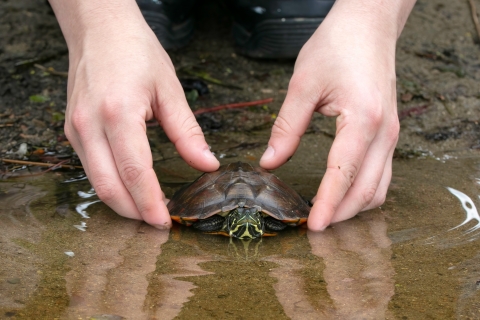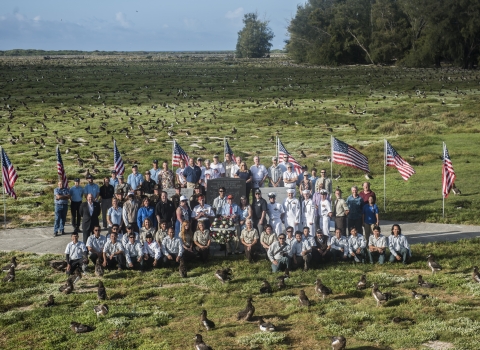Every May, about 100 northern red-bellied cooters graduate from MassWildlife’s Headstart Program and head out into the real world — specifically, the ponds where they came from in southeastern Massachusetts.
Through the program, now in its 38th year, the state coordinates with museums, nonprofit organizations, and schools to provide temporary foster homes to newly hatched northern red-bellied cooters, a federally endangered species, to protect them from predation when they are most vulnerable.
The turtles that participate in the Headstart Program are high-achievers. In the wild, few hatchlings live to see their first birthdays. The majority of released head-started cooters do.
That’s in no small part because when they return to the wild, they are significantly bigger than cooters that haven’t gone through the program. When cooters hatch in late summer or early fall, they weigh about 8 grams. Those that overwinter in the wild weigh about the same the following spring. The average weight of a headstarted cooter at graduation time is 167 grams.
The day before they’re released, they all report to the MassWildlife Field Headquarters for final exams, to make sure they measure up.
“We’re weighing them, measuring them, and PIT-tagging them,” explained state herpetologist Mike Jones, as he deftly inserted a tiny tracking device — about the size of a chocolate sprinkle — into a cooter.
Like microchips veterinarians put in cats and dogs, Passive Integrated Transponder (PIT) tags give individual turtles a unique identification code.
“The tags should last the whole life of the animal — about 70 or 80 years,” Jones said.
Those unique IDs were instrumental in a recent four-year study MassWildlife conducted in partnership with the U.S. Fish and Wildlife Service to calculate survivorship rates within cohorts of headstarted turtles in the wild. Over the years, cooters have been released at about 30 sites, including more than 15 ponds and pond complexes that had no prior evidence of existing or historical occupancy by cooters but offered suitable habitat.
In the study, MassWildlife focused on those sites to determine the proportion of cooters in each graduating class that are still alive.
“The rates were really high, all above 90 percent,” Jones said. “Some were as high as 98 percent.”
It appears headstarted cooters are not only bigger than their wild counterparts when released, but also more likely to survive.
Using the study data, biologists estimated survivorship for the 4,700 headstarted cooters that have been released back into the wild since the program started in the 1980s.
“How many do we think are still living? It’s probably more than 2,000,” Jones said.
For context, when the species was listed as endangered under the Endangered Species Act in 1980, biologists estimated there were only 200 northern red-bellied cooters left in Massachusetts, in just 12 ponds in Plymouth County. Thought to be a subspecies of the more broadly distributed northern red-bellied cooter, the isolated population was dubbed the Plymouth redbelly turtle.
Over the past four decades, taxonomists have revisited the classification issue — the southeastern Massachusetts cooters are now understood to be a geographically isolated population of the northern red-bellied cooter, rather than a subspecies — and partners have helped them rebound in Massachusetts.
"The Headstart Program has successfully increased both the size and extent of the northern red-bellied cooter population in Massachusetts,” said Eliese Dykstra, fish and wildlife biologist for the Service.
“Partners play such an important role in supporting species recovery,” she added. “Everyone who has been involved with this program, from coordinating logistics to scrubbing tanks, is part of the northern red-bellied cooter's ongoing conservation story.”
On top of boosting northern red-bellied cooter numbers, the program has raised awareness about the plight of the elusive turtle by engaging about a dozen institutions and hundreds of individuals in fostering young cooters, including students at local high schools.
If you wonder whether this formative experience in reptile conservation has an impact on the students who participate, just ask the state herpetologist.
“When I was in high school, I raised some of the headstarts,” Jones said. His school wasn’t one of those participating in the program — he reached out to retired Assistant Director of MassWildlife’s Natural Heritage and Endangered Species Program Tom French, who ran the program at the time.
“I told him I was really interested in turtles, and he said: We still have two left – why don’t you come pick them up?” Jones recalled. “I was so excited.”
By providing a window into both the challenges and opportunities in species conservation, the Headstart Program has also provided inspiration to those who will take over this work in the future.
Learn more about the Service’s work to support turtle conservation, and what you can do to help: How you can help turtles








